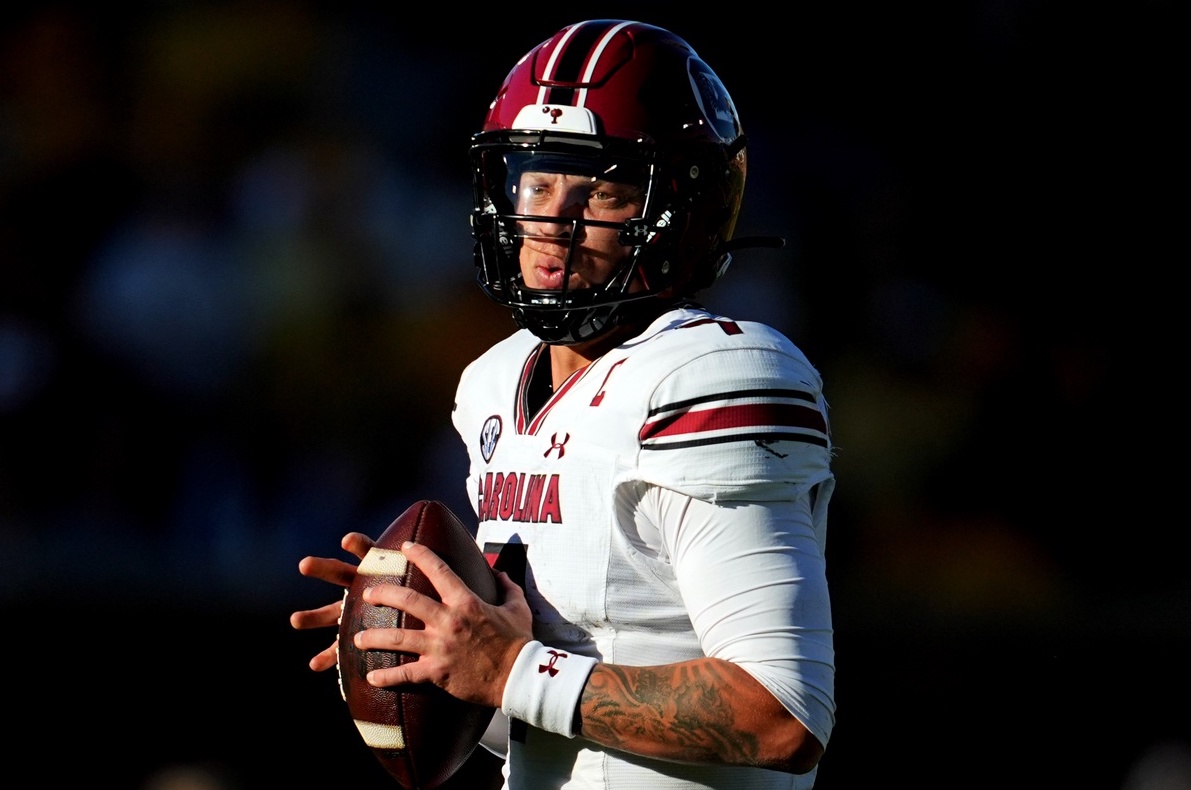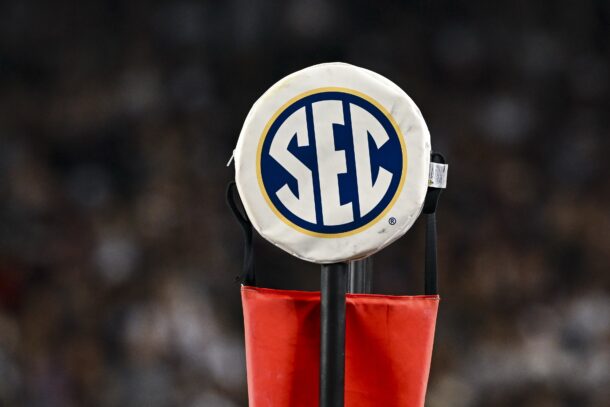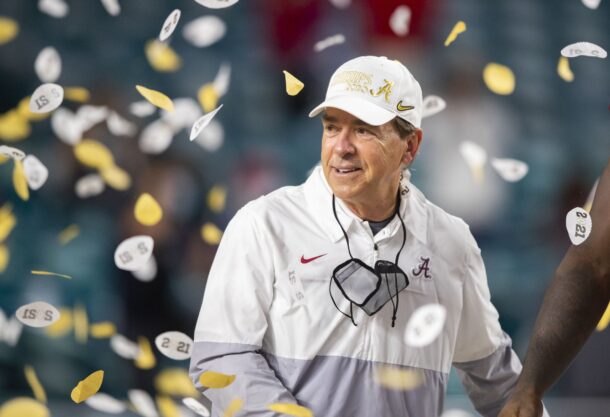
Becoming a starting quarterback in the SEC can be a winding road with potholes galore, or a straightaway without a single pebble in the way.
It’s never been more true that SEC quarterbacks come from a variety of backgrounds. Look no further than the newest Heisman Trophy winner, Jayden Daniels. As a 3-year starter at Arizona State, Daniels had an up-and-down career that brought him to Baton Rouge … OK, you already know that.
What you might not know — or at least might need to be reminded of — is how every QB1 got to the SEC in 2023, which seems especially important ahead of the start of the Early Signing Period on Wednesday. Were they a homegrown recruit or were they a transfer? Did they stay after a previous coaching staff departed?
Let’s dig into it and provide some context as we count down to Wednesday’s start of the Early Signing Period and welcoming the SEC’s next QB class:
Alabama — Jalen Milroe, recruit
I wouldn’t say that Milroe’s path to becoming Alabama’s QB1 was without potholes. After all, Alabama had the most well-documented QB battle of any team in the offseason, and Milroe’s struggles against Texas led to Nick Saban doing something that he hadn’t done since Jake Coker in 2015. That is, start a transfer QB. Of course, the Tyler Buchner experiment was a short one, and Milroe became a top-6 vote-getter in the Heisman Trophy. You know. As one does.
Arkansas — KJ Jefferson, recruit
As awkward and sad as Jefferson’s 2023 season was, we need to appreciate that the man endured the Chad Morris era and stayed to become a 3-year starter. On top of that, he didn’t bolt in 2020 when Sam Pittman brought in Feleipe Franks to be the Hogs’ QB1 in that first season. Jefferson learned from Franks and it allowed him to become a prolific quarterback who helped get the program back on track. It’s a shame that it ended the way it did.
Auburn — Payton Thorne, transfer
Thorne was the rare post-spring transfer quarterback. While I believe there are exceptions to that rule — Joe Burrow and Will Levis were post-spring enrollees with their respective SEC teams — history has shown that a post-spring transfer often struggles out of the gate. The same was true of Thorne, who was part of Michigan State’s magical 2021 season with Kenneth Walker III, but was also benched on 3 different occasions in East Lansing. Whether he’s Hugh Freeze’s QB1 for 2024 remains to be seen.
Florida — Graham Mertz, transfer
I’ll be 100% honest. I was wrong on Mertz. After watching him a good amount at Wisconsin, I kept waiting for him to look like the guy I watched in the 2019 U.S. Army All-American Bowl. That didn’t happen. Billy Napier saw something that I didn’t. Granted, Mertz was never going to be a game-changer. If he was, Florida wouldn’t have finished 5-7. The problem was the offensive line issues and the self-inflicted mistakes. It also didn’t help that the downfield shots were limited. Mertz bridging the DJ Lagway gap — and helping Napier survive that gauntlet schedule Year 3 — is now priority No. 1.
Georgia — Carson Beck, recruit
Beck is a bit of a throwback. Instead of leaving after Stetson Bennett IV passed him on the depth chart in 2021, Beck waited his turn for 3 years until finally getting that opportunity in Year 4. While Georgia didn’t 3-peat, Beck certainly lived up to some high expectations. In a weird way, he followed the most straight-line path of any Georgia QB since Jake Fromm, though obviously Fromm waited 1 game to take over the starting role after the Jacob Eason injury in the 2017 opener. Beck sticking around 3 years paid off for him, and it paid off for Georgia.
Kentucky — Devin Leary, transfer
Leary’s path to QB1 status in Kentucky was more of the modern mold. He was a multi-year starter at NC State who sought a new situation and was considered a major get in the portal. You could argue that both Leary and Kentucky were right in their decisions to unite, but that it just didn’t work out. How much of that was impacted Leary’s atypical procedure after his season-ending pec injury in 2022 compared to UK’s inconsistent receiver room is debatable. Whatever the case, Leary’s struggles didn’t close the portal door for Kentucky at quarterback. Brock Vandagriff will appear in this column next year.
LSU — Jayden Daniels, transfer
Just in case you haven’t heard, Daniels’ exit from Arizona State wasn’t quiet. In less than 2 years, he went from having a viral video of ASU teammates cleaning out his locker to hoisting the Heisman Trophy. Let’s not forget that Daniels’ decision to come to LSU didn’t guarantee that he’d be the starter. Veteran Myles Brennan was expected to have a legitimate crack at that, as was the talented gunslinger Garrett Nussmeier. But Brennan retired and Nussmeier wasn’t ready as a redshirt freshman. The rest is history.
Mississippi State — Will Rogers, recruit
It’s easy to forget that much like Jefferson, Rogers signed with previous staff. Like, the Joe Moorhead staff. But he stayed for the Air Raid offense with Mike Leach and became the No. 2 passer in SEC history. Also like Jefferson, 2023 was a lost year in a new, ineffective offense that ended with him in the portal. How Rogers looks at Washington after 4 years in Starkville remains to be seen. Given the nature of the position, it seems foolish to write off the idea that he’s leading a nationally relevant offense in 2024.
Mizzou — Brady Cook, recruit
Like the aforementioned Beck, Cook also followed a more linear progression at Mizzou. He got a shot at the starting job in the bowl game at the end of the 2021 season after Connor Bazelak’s struggles led to his departure. Cook has since started every game, though not without controversy. He was booed before the Kansas State game, which led to some animated comments from Eli Drinkwitz. It also led to Cook putting together an impressive season as one of the SEC’s top signal-callers. Drinkwitz’s faith in Cook instead of turning to fan favorite Sam Horn or Miami transfer Jake Garcia looks like a smart move.
Ole Miss — Jaxson Dart, transfer
What do Dart and Lane Kiffin have in common? Both left USC sooner than expected. Dart left USC after a coaching change while Kiffin left … also after a coaching change (technically). Dart had to win quarterback battles in both offseasons in Oxford. He beat out Luke Altmyer in Year 1, and then he fended off the likes of transfers Spencer Sanders (a 4-year starter from Oklahoma State) and Walker Howard (a blue-chip recruit who spent 1 year at LSU). Dart’s toughness will never be questioned, both mentally and physically. He developed into an ideal fit to work with Kiffin.
South Carolina — Spencer Rattler, transfer
This is why the transfer portal market for quarterbacks will always be intriguing. Rattler didn’t live up to the ridiculously high bar set by his predecessors at Oklahoma, but that didn’t mean he was damaged goods. At South Carolina, Shane Beamer showed patience and confidence with Rattler. Yes, the Gamecocks went 5-7 and Rattler isn’t going to be a first-round pick like many projected before 2021. But anyone who actually watched Rattler saw him develop into a much more polished quarterback who had nothing but glowing remarks internally, both as a player and as a leader.
Tennessee — Joe Milton, transfer
I don’t know that anyone in college football had a path quite like Milton’s. Think about it. He started at Michigan in 2020, got benched and got another shot to be QB1 in Josh Heupel’s first offense at Tennessee … only to watch Hendon Hooker take his job and run with it. Most quarterbacks would’ve bolted for a 3rd school. Milton didn’t, and he was rewarded with his 3rd attempt at a starting job. Tennessee’s offense didn’t live up to the Heupel standard — it was Heupel’s first offense as a head coach that didn’t finish in the top 8 in FBS in scoring — but Milton did at least help bridge the gap to Nico Iamaleava.
Texas A&M — Conner Weigman, recruit
Weigman was Jimbo Fisher’s highest-rated recruit since Jameis Winston in 2012. Unfortunately for Weigman — and perhaps for Fisher — Weigman’s season was cut short due to an injury in late September. While Weigman didn’t look like a finished product, he showed plenty of promise after beating out transfers Max Johnson and Jaylen Henderson, both of whom had their moments as starters in 2023. Weigman was part of A&M’s historic 2022 class, which has since seen 10 of the 24 recruits rated as 4- or 5- stars hit the portal. As long as Weigman stays, he could be a crucial part of the Aggies’ path to navigating the expanded SEC in Year 1 of the Mike Elko era.
Vanderbilt — AJ Swann, recruit
Swann was the rare Elite 11 guy who picked Vandy. As a 4-star recruit in the 247sports composite rankings, Swann looked like he was getting the keys to the car in Year 2, only to have them taken away after suffering an injury. The problem was that nobody really ran with the starting job, and Clark Lea’s insistence on trying out several quarterbacks led to all of them hitting the portal at season’s end. Perhaps Swann will get the keys to the car at South Carolina, which knows a thing or 2 about developing a portal quarterback who lost his starting job.
Some thoughts on that …
Here’s the breakdown:
- 7 of 14 SEC QB1s were transfers
- Of the 7 SEC QB1s who were recruits, only 2 stayed amid a head coaching change (Rogers and Jefferson)
- Of the 7 SEC QB1 homegrown recruits, 3 hit the portal at season’s end
- In 2024, Alabama, Oklahoma and Tennessee might be the only SEC locks to have homegrown recruits as QB1 (TBD on Georgia with Carson Beck)
That last bullet is the key. This column next year will almost certainly feature at least half transfers. My guess is that number will be closer to 10 of the 16 SEC QB1s will be former transfers. All you need to know about the “why” is that the portal market for quarterbacks includes the overwhelming majority of Power 5. Alabama is now the outlier to have an established, homegrown QB1 who is set to return next year.
It’s obviously not just an SEC thing. All 3 of this year’s Heisman Trophy finalists at the QB position were former transfers. In the past 3 years, Bryce Young, CJ Stroud and Max Duggan are the only homegrown QBs who made it to New York. Expect that to continue in the 2020s.
It looks like it’ll continue to be the norm in the SEC.
Connor O'Gara is the senior national columnist for Saturday Down South. He's a member of the Football Writers Association of America. After spending his entire life living in B1G country, he moved to the South in 2015.







